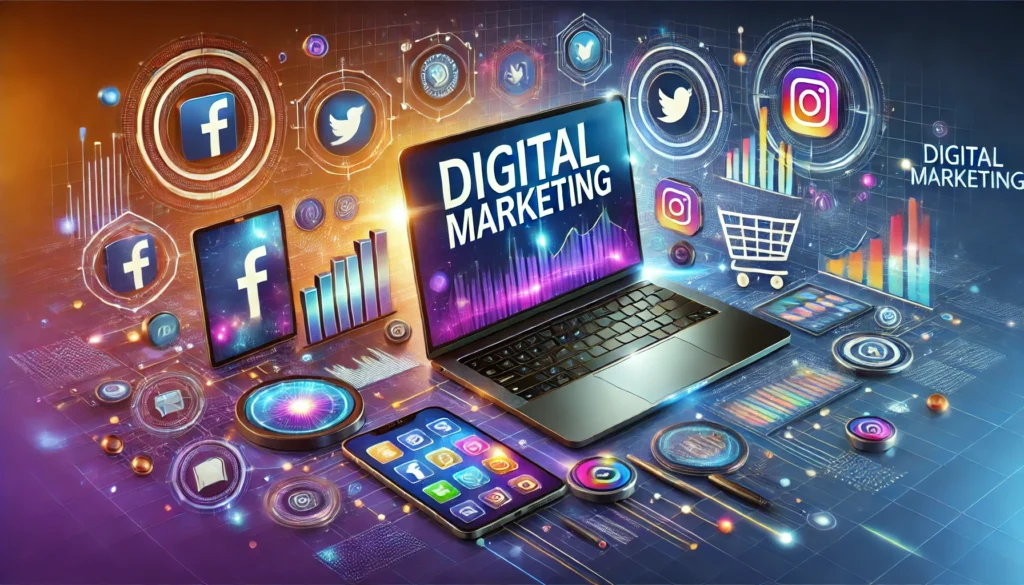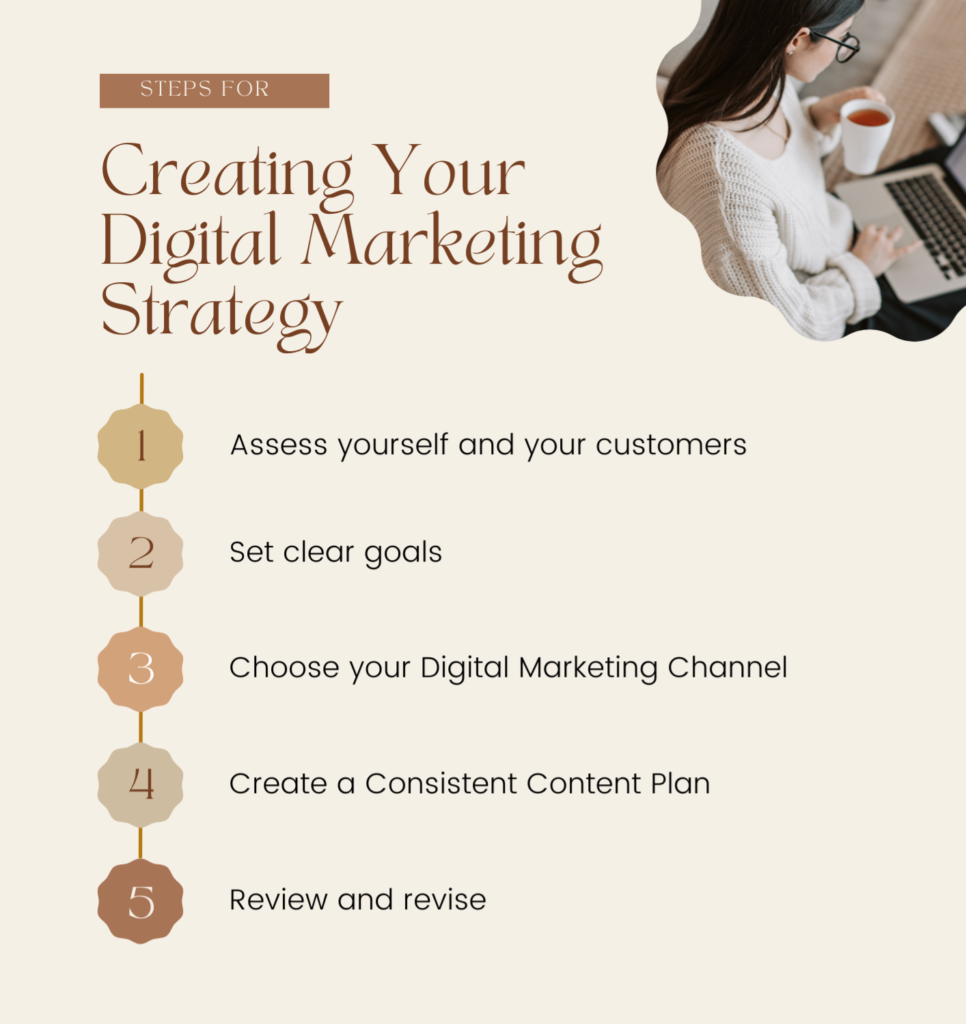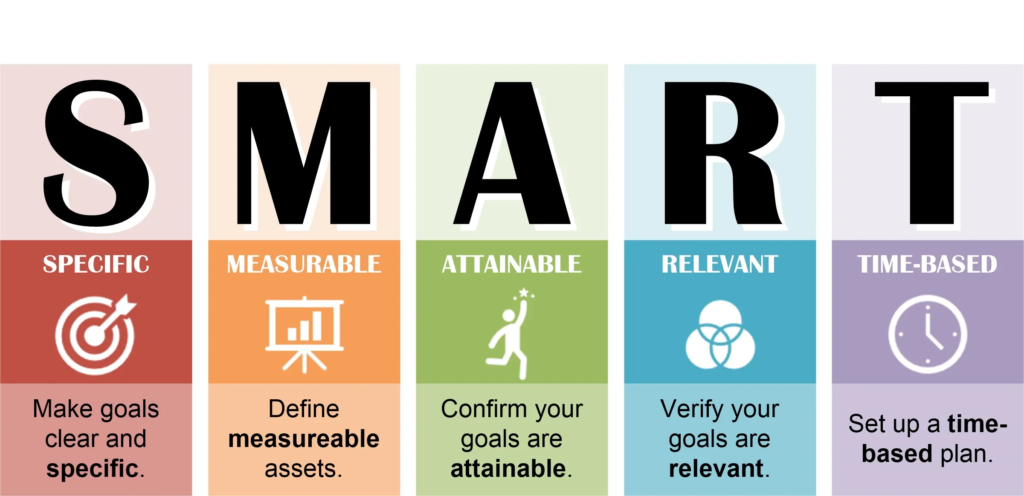Running any web-based service requires making use of digital marketing. A staggering 80% of people on the internet use it to look up information on products or services they’re searching for. No matter what kind of business you run, there’s no getting around the use of digital marketing. And if you have to do it, you do it the best way you can, right? You’re a businessman, after all.

For you who’s looking for the best course of action to come up with your own digital marketing strategy, we’ve put together a comprehensive step-by-step guide that includes anything and everything you’d ever need. Let’s dive right in!
Table of Contents
What is a marketing strategy and why it’s needed
A digital marketing strategy means using different online channels like SEO, PPC, social media, and content marketing to meet your business goals. Every business’s approach will be unique depending on their goals and audience.
Among the 4.2 billion internet users in the world, a vast majority are involved in digital communication channels. Often their choice of product or services is shaped by advertisements they come across. To be one of those who get noticed in the virtual world and attract potential customers, well-planned digital marketing campaigns are necessary.
Without a clear plan, your digital marketing strategy might feel scattered, and it’ll be tough to get the results you want. Plus, having a strategy helps make sure that you’re spending your budget wisely. Now let’s take a look at the steps.

Step 1: Assess yourself and your customers
So, first of all, you need to take a good look at what you have: what kind of business you’re running, its current reach, and your target audience. Your customers need focused attention – research their interests and behaviour.
W’s are important: What kind of ads pique their attention, when is the preferred time of browsing for them, or where you’re not reaching enough. The list goes on. Get as much information about your customers’ location, age, gender, income, job etc.
You need to audit your business’s presence. Review your website, social media, and any active digital campaigns. You can use tools like Google Analytics, social media insights, or SEO tools to get data on your performance and check which aspects need improvement.
It’s also a good idea to observe the state of your competitors in the same field and their marketing strategies.
Step 2: Set clear goals
Then set the milestones you want to achieve. Whether it’s more website traffic, increased sales, or greater brand awareness, setting clear goals is vital to build your digital marketing strategy step-by-step.

You can make use of SMART goals to keep things focused. SMART goals are a framework for setting clear and achievable objectives. Here’s a quick breakdown:
- S – Specific: Clearly define what you want to accomplish. The goal should be focused and well-defined (e.g., “Increase website traffic” vs. “Get more visitors”).
- M – Measurable: Your goal should have measurable criteria so you can track progress. This could be a number or percentage (e.g., “Increase traffic by 20%”).
- A – Achievable: Set a goal that is realistic and attainable, considering your resources and constraints (e.g., doubling sales in a month might not be feasible).
- R – Relevant: Make sure the goal aligns with your overall business objectives and is worthwhile (e.g., increasing Instagram followers might not be relevant if your audience isn’t on that platform).
- T – Time-bound: Set a deadline or timeframe for achieving the goal (e.g., “Increase traffic by 20% in the next three months”).
Step 3: Choose your Digital Marketing Channel
What’s that, you say? A digital marketing channel is an online platform or method used to promote products, services, or a brand to an audience. These channels allow businesses to connect with potential customers, share content, and drive traffic to websites or landing pages. Some common digital marketing channels include social media, email, search engines, websites, and online advertising platforms.

Pick depending on your customer base
This is where things get tricky. Choosing the right marketing channels is critical for a successful digital marketing strategy. Each channel has its strengths, and the right combination depends on your business goals, target audience, and available resources. So the correct choice is highly situational, but we can give you some pointers on how to pick.
You can make your choice depending on your audience’s age and occupation. Younger audiences might be more active on platforms like Instagram, TikTok, or YouTube, while Professionals and B2B customers are likely found on LinkedIn.
Use market research, customer data, and insights from your current followers to identify which platforms they use most and go with those.
There’s also the matter of what kind of content your audience would like. Some audiences prefer video content, while others might engage more with blogs or podcasts.
The most important thing to keep in mind is that you must-
Align Channels with Your Business Goals
If your goal is brand awareness, social media platforms like Instagram, Facebook, or TikTok might be best, since they allow for a wide reach and high engagement.
If lead generation is your focus, email marketing, SEO, and PPC (Google Ads) can help capture more qualified leads.
For building relationships and retaining customers, email marketing, customer support chatbots, and content marketing are effective tools.
Marketing automation tools are your best friends. They can be customized for numerous marketing channels to serve an immense number of customers. Utilize them to save yourself a lot of unnecessary efforts.
Step 4: Create a Consistent Content Plan
Once you’ve decided which channels you want to use, the next step in your digital marketing plan will be to fix a timeline for your content.
It’s a good idea to develop a content calendar for consistent and relevant posting. The content in this context may be anything ranging from blog posts, videos, infographics, social media posts; basically anything that can contribute to a digital marketing campaign.
Make sure to align your content with the different stages of the customer journey (awareness, consideration, decision). You should simultaneously allocate a budget for your digital marketing strategy. The timeline will help with this too as it will give you a clear understanding of how much you will need to spend at which time of the calendar.
Step 5: Review and revise
Pat yourself on the back! You’ve built up your digital marketing strategy step-by-step. But wait, that’s not the end. Just because you’ve fixed a plan doesn’t mean it won’t need to be modified to adapt to circumstances that change with time.

Your short and sweet chore list includes:
- Tracking your results regularly (weekly, monthly) using analytics tools.
- Focusing on key performance indicators (KPIs) like traffic, conversions, and engagement.
Optimize your digital marketing strategy based on what’s working. Data visualization works great in comparing your goals and actual progress. Adjust your strategy if needed, whether it’s tweaking ad copy, targeting, or content approach.
That’s about it, really
This step-by-step guide to building your digital marketing strategy, while a reliable outline, may not be enough for those looking for guides to their specific business. We encourage them to look up our article on Digital Marketing Frameworks.
Digital marketing is constantly changing. Experiment with new tactics and strategies to see what works best for your audience. And of course, don’t forget to stay updated with the latest trends and platform updates!
Glossary of Terms

B2B: Business-to-business (B2B) is a type of transaction that occurs between two businesses, such as a manufacturer and a wholesaler, or a wholesaler and a retailer. Business-to-business transactions usually involve goods and services that help one business to operate.
KPI: KPI stands for key performance indicator, a quantifiable measure of performance over time for a specific objective. KPIs provide targets for teams to shoot for, milestones to gauge progress, and insights that help people across the organization make better decisions.
Marketing Automation Tools: Marketing automation is the process of utilising technology to streamline marketing efforts and make them more effective. It uses a single automation platform to manage every aspect of every campaign from the same place, like email and social media marketing, mobile messaging, and managing ads. Marketing automations tools refers to softwares that carry it out.
PPC: Pay-per-click is an internet advertising model used to drive traffic to websites, in which an advertiser pays a publisher when the ad is clicked. Pay-per-click is usually associated with first-tier search engines.
SEO: Search Engine Optimization is the process of improving the quality and quantity of website traffic to a website or a web page from search engines. SEO targets unpaid traffic rather than direct traffic or paid traffic.
Traffic: Website traffic is the volume of users on a site over a set time. Traffic is usually measured in web visits, sometimes called “sessions.” For example, if your site gets 100 users every day, your traffic after a week would be 700 users.
